Compaction Behavior and Damage Constitutive Model for Porous Cement Mortar under Uniaxial Cyclic Loads
Abstract
1. Introduction
2. Materials and Methods
2.1. Specimen Preparation and Experimental Devices
2.2. Test Process
3. Analysis of Stress–Strain Curves
3.1. Stress–Strain Curves
3.2. The Relationship between Irreversible Strain and Unloading Stress
4. Analysis of Damage Evolution
5. Damage Constitutive Model for Porous Cement Mortar
6. Conclusions
Author Contributions
Funding
Institutional Review Board Statement
Informed Consent Statement
Data Availability Statement
Acknowledgments
Conflicts of Interest
References
- Li, Y.; Li, H.; Jin, C. Effect of multi-walled carbon nanotubes on the damping property of cement mortar and mechanism analysis. Arch. Civ. Mech. Eng. 2021, 21, 102. [Google Scholar] [CrossRef]
- Hussein, W.G.A.; Al-Sultan, A.A.; Al-Ani, F.H. Acoustic and thermal insulation properties of recycled aggregate mortar. IOP Conf. Ser. Mater. Sci. Eng. 2021, 1067, 012022. [Google Scholar] [CrossRef]
- Guerrero, A.; Goni, S.; Lorenzo, M.P. Long term durability at 40 °C of ecoefficient belite cement-mortar exposed to sulfate attack. Adv. Cem. Res. 2008, 2, 139–144. [Google Scholar] [CrossRef]
- Yang, R.Z.; Xu, Y.; Chen, P.Y.; Gong, J. Static Compressive properties and damage constitutive model of rubber cement mortar with dry- and wet-curing conditions. J. Cent. South Univ. 2021, 28, 2158–2178. [Google Scholar] [CrossRef]
- Chen, D.; Du, C.; Feng, X.G.; Ouyang, F. An elastoplastic damage constitutive model for cementitious materials under wet-dry cyclic sulfate attack. Math. Probl. Eng. 2013, 2013, 562410. [Google Scholar] [CrossRef]
- Kakavas, P.A.; Konstantinidis, A.; Hatzitrifon, N.K.; Papadopoulos, P.; Aifantis, E.C. On the Constitutive Equations of Fresh Mortar. J. Mech. Behav. Mater. 2016, 25, 183–187. [Google Scholar] [CrossRef]
- Chidiac, S.E.; Mahmoodzadeh, F. Constitutive flow models for characterizing the rheology of fresh mortar and concrete. Can. J. Civil Eng. 2013, 40, 475–482. [Google Scholar] [CrossRef]
- Loukidis, A.; Stavrakas, I.; Triantis, D. Electrical methods for sensing damage in cement mortar beams combined with acoustic emissions. Materials 2022, 15, 4682. [Google Scholar] [CrossRef]
- Li, D.S.; Ou, J.P. Damage evolution prediction and model of cement mortar based on acoustic emission. In Proceedings of the Fundamental Problems of Optoelectronics and Microelectronics II, Khabarovsk, Russia, 13–16 September 2004; SPIE: Bellingham, WA, USA, 2005; Volume 5851, pp. 267–272. [Google Scholar]
- Zhou, J.K.; Chen, X.D. Stress-strain behavior and statistical continuous damage model of cement mortar under high strain rates. J. Mater. Civil Eng. 2013, 25, 120–130. [Google Scholar] [CrossRef]
- Xie, Y.J.; Fu, Q.; Zheng, K.R.; Yuan, Q.; Song, H. Dynamic mechanical properties of cement and asphalt mortar based on SHPB test. Constr. Build. Mater. 2014, 70, 217–225. [Google Scholar] [CrossRef]
- Tan, Y.; Gu, Q.; Ning, J.; Liu, X.; Jia, Z.; Huang, D. Uniaxial compression behavior of cement mortar and its damage-constitutive model based on energy theory. Materials 2019, 12, 1309. [Google Scholar] [CrossRef]
- Zhu, S.Y.; Fu, Q.; Cai, C.B.; Spanos, P.D. Damage evolution and dynamic response of cement asphalt mortar layer of slab track under vehicle dynamic load. Sci. China Technol. Sci. 2014, 57, 1883–1894. [Google Scholar] [CrossRef]
- Chen, X.T.; Shao, J.F.; Davy, C.A.; Skoczylas, F. Experimental study and constitutive modeling of elasto-plastic damage in heat-treated mortar. Int. J. Numer. Anal. Met. 2010, 34, 357–382. [Google Scholar] [CrossRef]
- Shao, J.F.; Henry, J.P. Development of an elastoplastic model for porous rock. Int. J. Plasticity 1991, 7, 1–13. [Google Scholar] [CrossRef]
- Li, Y.Y.; Huang, X.Q.; Mao, W.X. A Theoretical model and experimental investigation of a nonlinear constitutive equation for elastic porous metal rubbers. Mech. Compos. Mater. 2005, 41, 303–312. [Google Scholar]
- Zhou, Z.; Du, X.M.; Chen, Z.; Zhao, Y. Grouting diffusion of chemical fluid flow in soil with fractal characteristics. J. Cent. South Univ. 2017, 24, 1190–1196. [Google Scholar] [CrossRef]
- Castaneda, P.P.; Zaidman, M. Constitutive models for porous materials with evolving microstructure. J. Mech. Phys. Solids 1994, 42, 1459–1497. [Google Scholar] [CrossRef]
- Huang, Z.P.; Chen, Y.Q.; Bai, S.L. An elastoplastic constitutive model for porous materials. Int. J. Appl. Mech. 2013, 5, 50035. [Google Scholar] [CrossRef]
- Luo, X.; Xu, J.Y.; Liu, Y. The static constitutive model of fiber reinforced cellular Materials. Constr. Build. Mater. 2018, 187, 903–906. [Google Scholar] [CrossRef]
- Nunziato, J.W.; Cowin, S.C. Non-linear theory of elastic-materials with voids. Arch. Ration. Mech. Anal. 1979, 72, 175–201. [Google Scholar] [CrossRef]
- Green, R.J. Plasticity theory for porous solids. Int. J. Mech. Sci. 1972, 14, 215–224. [Google Scholar] [CrossRef]
- Hom, C.L.; McMeeking, R.M. Void growth in elastic-plastic Materials. J. Appl. Mech.—T. ASME 1989, 56, 309–317. [Google Scholar] [CrossRef]
- Abellan-Garcia, J. Study of nonlinear relationships between dosage mixture design and the compressive strength of UHPC. Case Stud. Constr. Mater. 2022, 17, e01228. [Google Scholar] [CrossRef]
- Eisa, M.S.; Mohamady, A.; Basiouny, M.E.; Abdulhamid, A.; Kim, J.R. Mechanical properties of asphalt concrete modified with carbon nanotubes (CNTs). Case Stud. Constr. Mater. 2022, 16, e00930. [Google Scholar] [CrossRef]
- Azevedo, A.R.; Marvila, M.T.; Zanelato, E.B.; Alexandre, J.; Xavier, G.C.; Cecchin, D. Development of mortar for laying and coating with pineapple fibers. Rev. Bras. Eng. Agric. Ambient. 2020, 24, 187–193. [Google Scholar] [CrossRef]
- Ueng, T.; Lyu, S.; Chu, H.; Lee, H.; Wang, T. Adhesion at interface of geopolymer and cement mortar under compression: An experimental study. Constr. Build. Mater. 2012, 35, 204–210. [Google Scholar] [CrossRef]
- Munoz, H.; Taheri, A. Postpeak deformability parameters of localized and nonlocalized damage zones of rocks under cyclic loading. Geotech. Test. J. 2019, 42, 1663–1684. [Google Scholar] [CrossRef]
- Balshin, M.Y. Relation of mechanical properties of powder metals and their porosity and the ultimate properties of porous-metal ceramic materials. Dokl. Akad. Nauk SSSR 1949, 67, 831–834. [Google Scholar]
- Chen, X.; Wu, S.; Zhou, J. Influence of porosity on compressive and tensile strength of cement mortar. Constr. Build. Mater. 2013, 40, 869–874. [Google Scholar] [CrossRef]
- Ghorbanbeigi, H.; Yurtdas, I.; Shen, W.Q.; Shao, J.F. Influences of chemical leaching on elastic and plastic properties of cement-based materials. Eur. J. Environ. Civ. Eng. 2017, 21, 696–711. [Google Scholar] [CrossRef]
- Peng, K.; Zhou, J.Q.; Zou, Q.L.; Yan, F.Z. Deformation characteristics of sandstones during cyclic loading and unloading with varying lower limits of stress under different confining pressures. Int. J. Fatigue 2019, 127, 82–100. [Google Scholar] [CrossRef]
- Jia, C.J.; Xu, W.Y.; Wang, R.B.; Wang, W.; Zhang, J.C.; Yu, J. Characterization of the deformation behavior of fine-grained sandstone by triaxial cyclic loading. Constr. Build. Mater. 2018, 162, 113–123. [Google Scholar] [CrossRef]
- Peng, K.; Zhou, J.; Zou, Q.; Zhang, J.; Wu, F. Effects of stress lower limit during cyclic loading and unloading on deformation characteristics of sandstones. Constr. Build. Mater. 2019, 217, 202–215. [Google Scholar] [CrossRef]
- Xi, D.; Liu, X.; Zhang, C. Analysis on micro and meso-damage of rock by macro-hysteresis curve. Chin. J. Rock Mech. Eng. 2003, 22, 182–187. (In Chinese) [Google Scholar]
- Xie, S.J.; Han, Z.Y.; Shu, R.H.; Chen, Y.F.; Feng, F. A new method to determine the crack closure stress based on stress difference. Theor. Appl. Fract. Mech. 2022, 119, 103337. [Google Scholar] [CrossRef]
- Yu, H.; Wu, J.; Li, Q. A rational method for defining damage variables in one dimension. J. Chongqing Univ. Nat. Sci. Ed. 2008, 31, 1261–1266. (In Chinese) [Google Scholar]
- Wang, G.; Lu, D.; Zhou, X.; Wu, Y.; Du, X.; Xiao, Y. A stress-path-independent damage variable for concrete under multiaxial stress conditions. Int. J. Solids Struct. 2020, 206, 59–74. [Google Scholar] [CrossRef]
- Zhao, K.; Huang, Z.; Yu, B. Damage characterization of red sandstones using uniaxial compression experiments. RSC Adv. 2018, 8, 40267–40278. [Google Scholar] [CrossRef]
- Meng, Q.B.; Liu, J.F.; Xie, L.X.; Pu, H.; Yang, Y.G.; Huang, B.X.; Qian, W. Experimental mechanical strength and deformation characteristics of deep damaged-fractured rock. Bull. Eng. Geol. Environ. 2022, 81, 32. [Google Scholar] [CrossRef]
- Chen, Y.; Guo, W.B.; Zuo, J.P.; Heng, S.; Dou, R. Effect of triaxial loading and unloading on crack propagation and damage behaviors of sandstone: An experimental study. Rock Mech. Rock Eng. 2021, 54, 6077–6090. [Google Scholar] [CrossRef]
- Xiao, J.; Ding, D.; Jiang, F.; Xu, G. Fatigue damage variable and evolution of rock subjected to cyclic loading. Int. J. Rock Mech. Min. 2010, 47, 461–468. [Google Scholar] [CrossRef]
- Li, X.; Xv, Q.; Xie, H.; Xiao, M.; He, J. Damage constitutive law and damage evolution characteristics for fractured rock under coupling action of static and dynamic load. Chin. J. Rock Mech. Eng. 2015, 34, 3029–3036. (In Chinese) [Google Scholar] [CrossRef]
- Lemaitre, J. A Continuous damage mechanics model for ductile fracture. J. Eng. Mater. Technol. ASME 1985, 107, 83–89. [Google Scholar] [CrossRef]
- Bian, K.; Liu, J.; Zhang, W.; Zheng, X.; Ni, S.; Liu, Z. Mechanical behavior and damage constitutive model of rock subjected to water-weakening effect and uniaxial loading. Rock Mech. Rock Eng. 2019, 52, 97–106. [Google Scholar] [CrossRef]
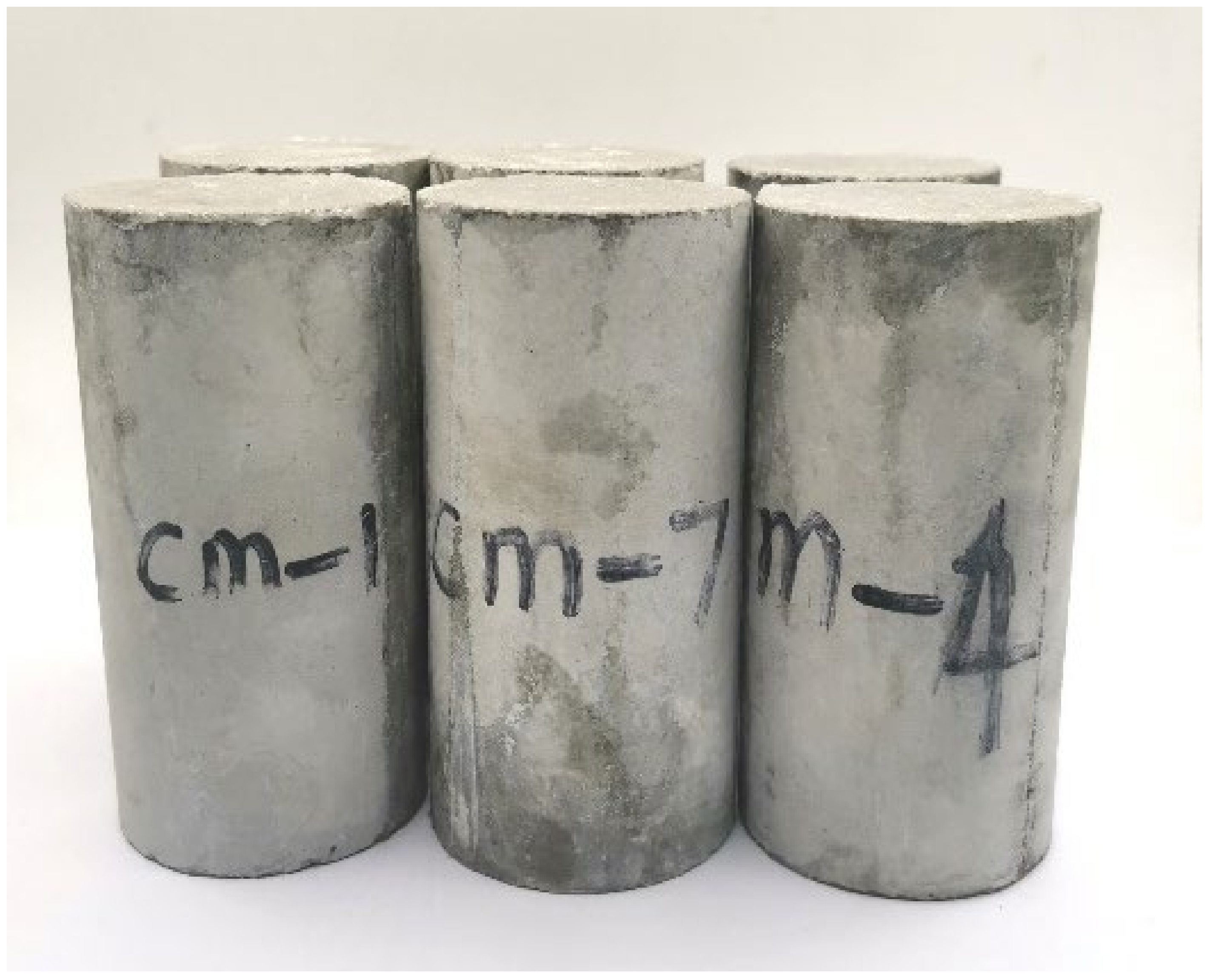
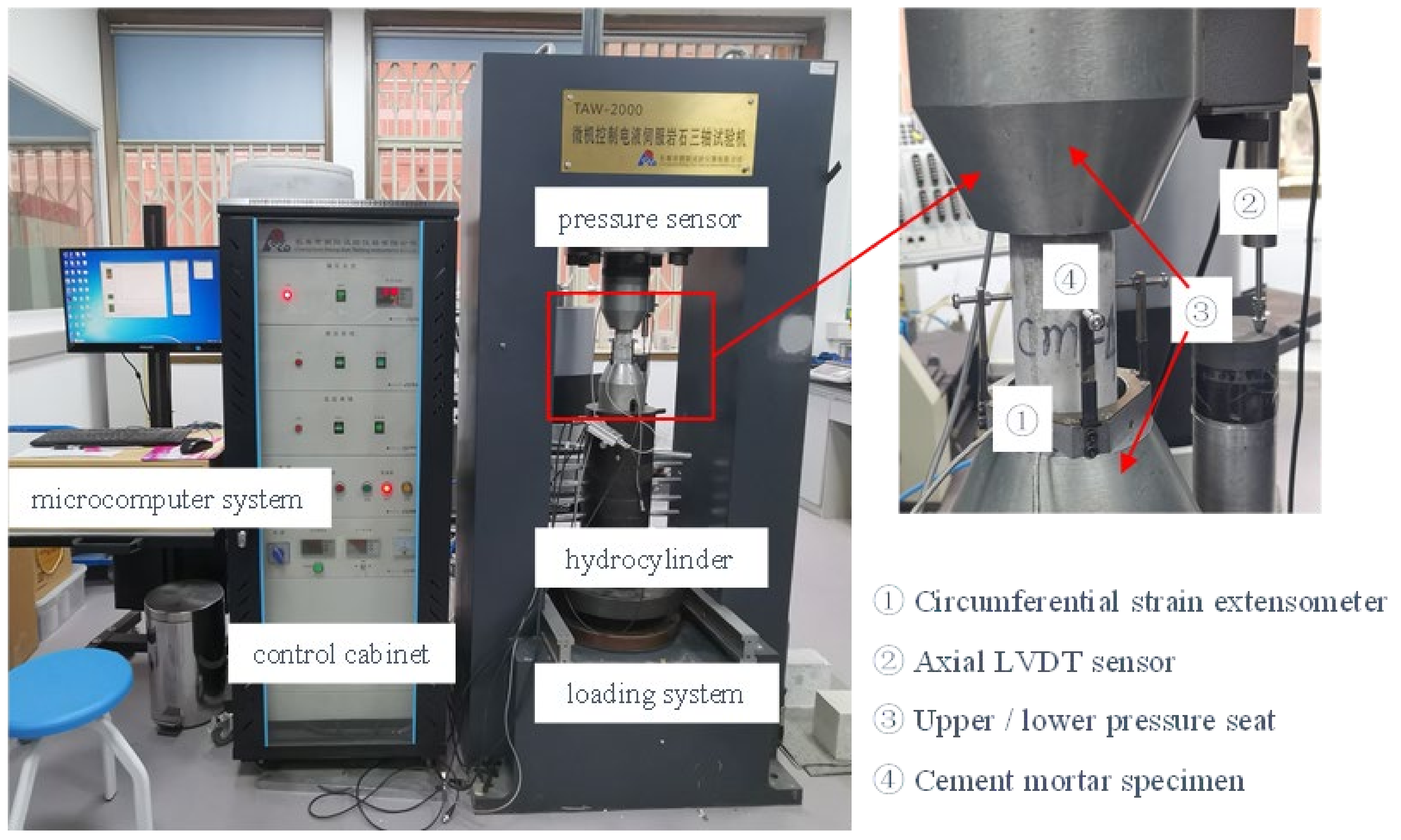
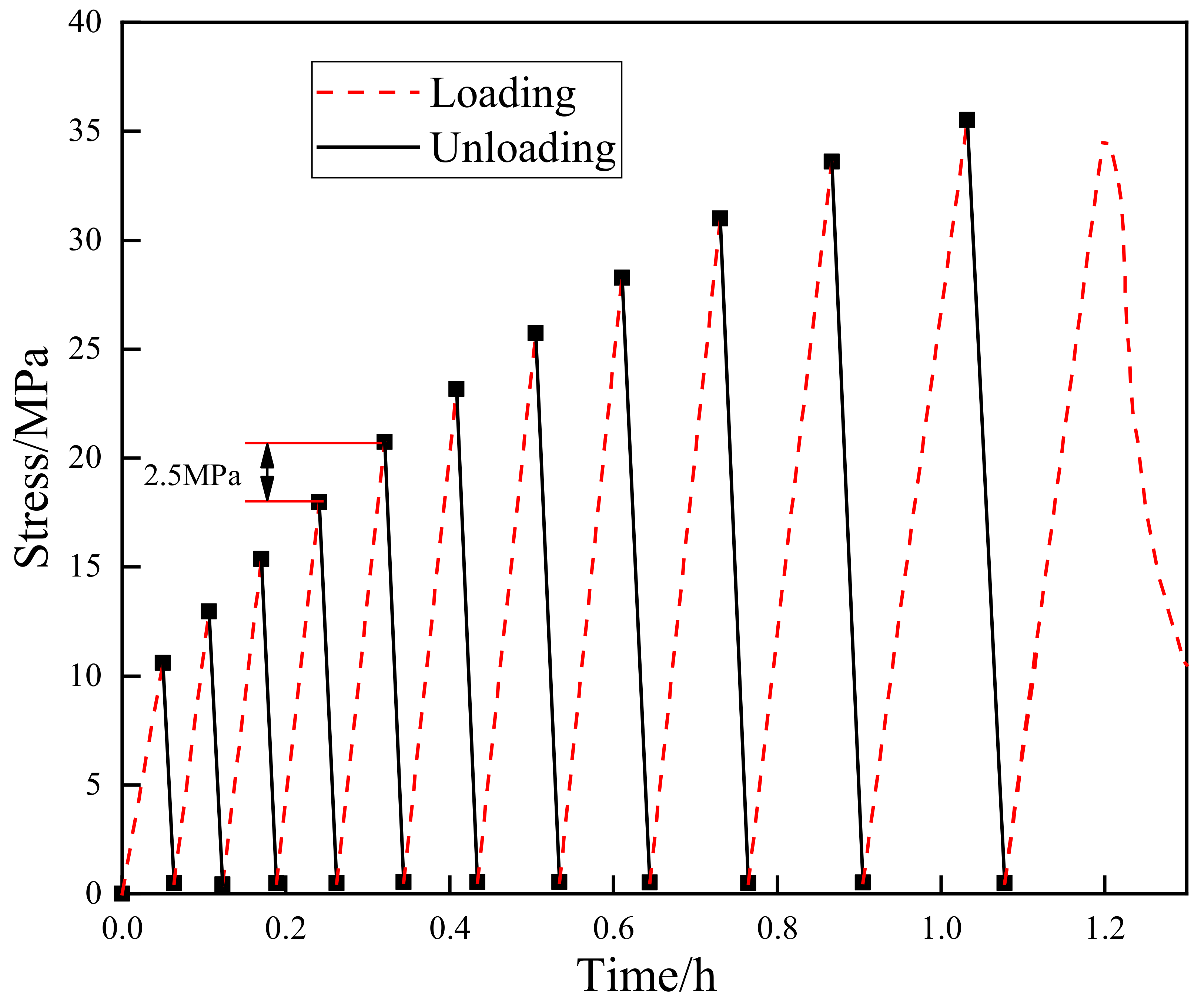
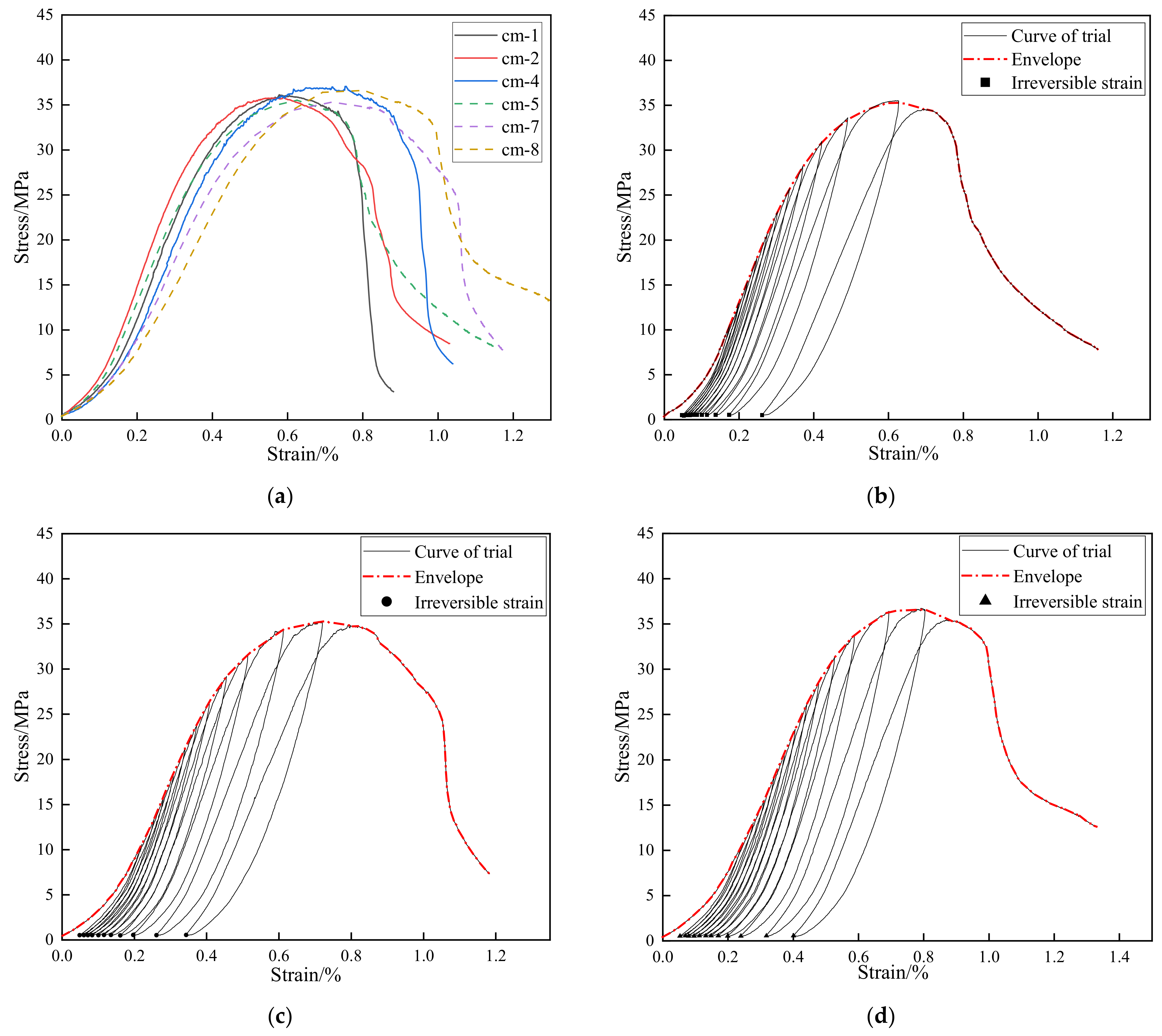
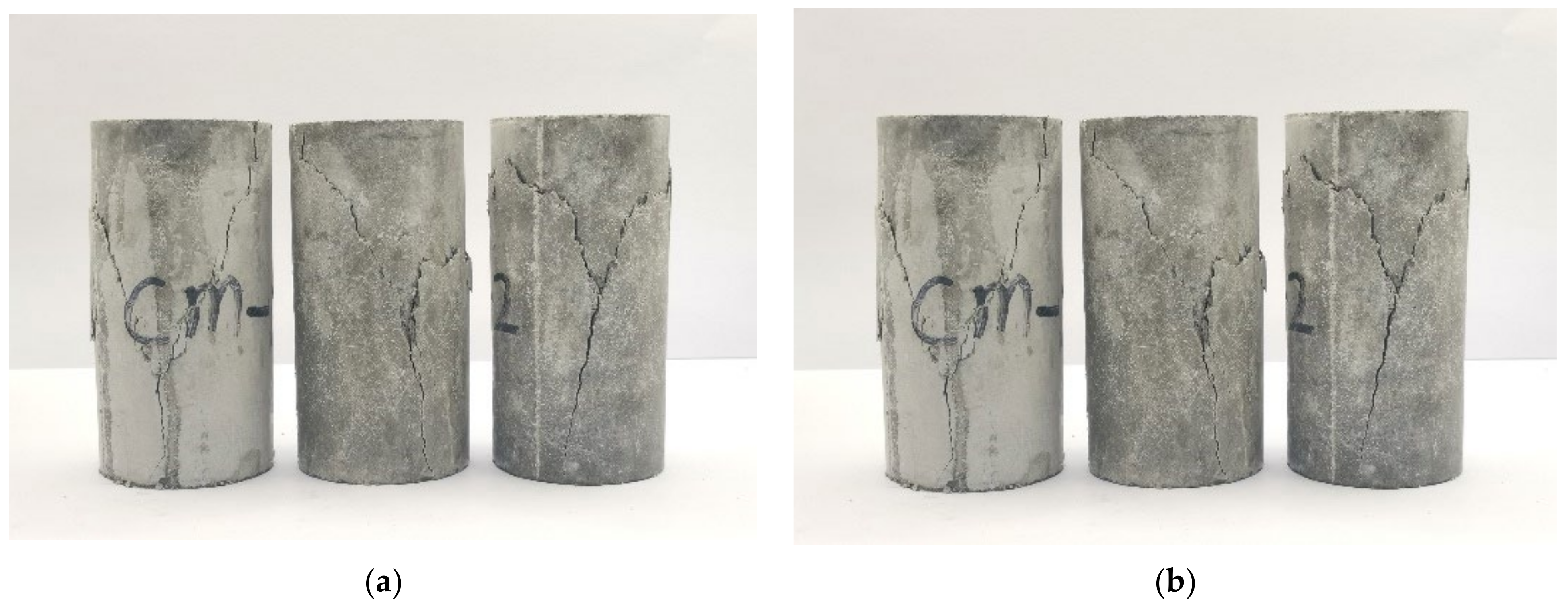
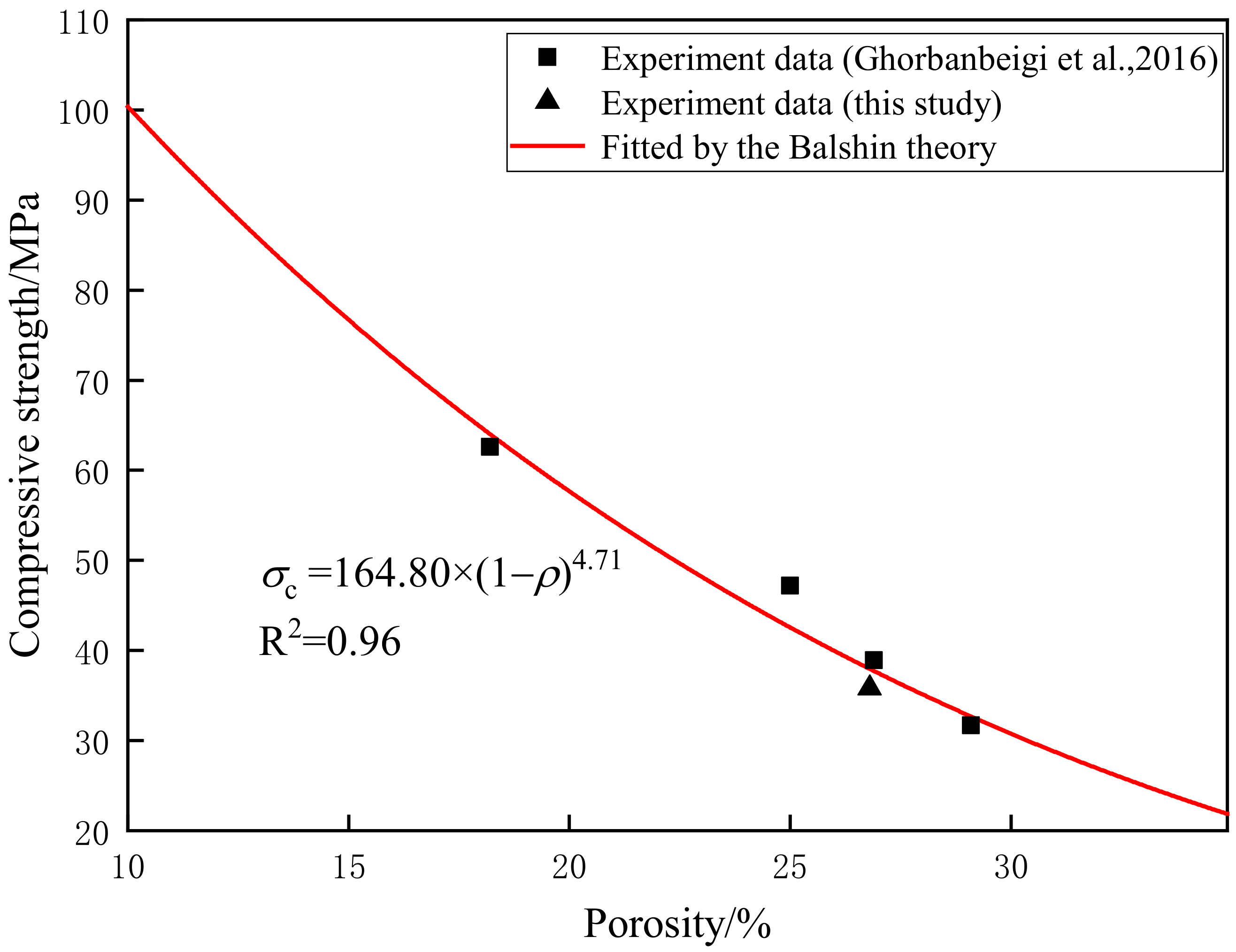
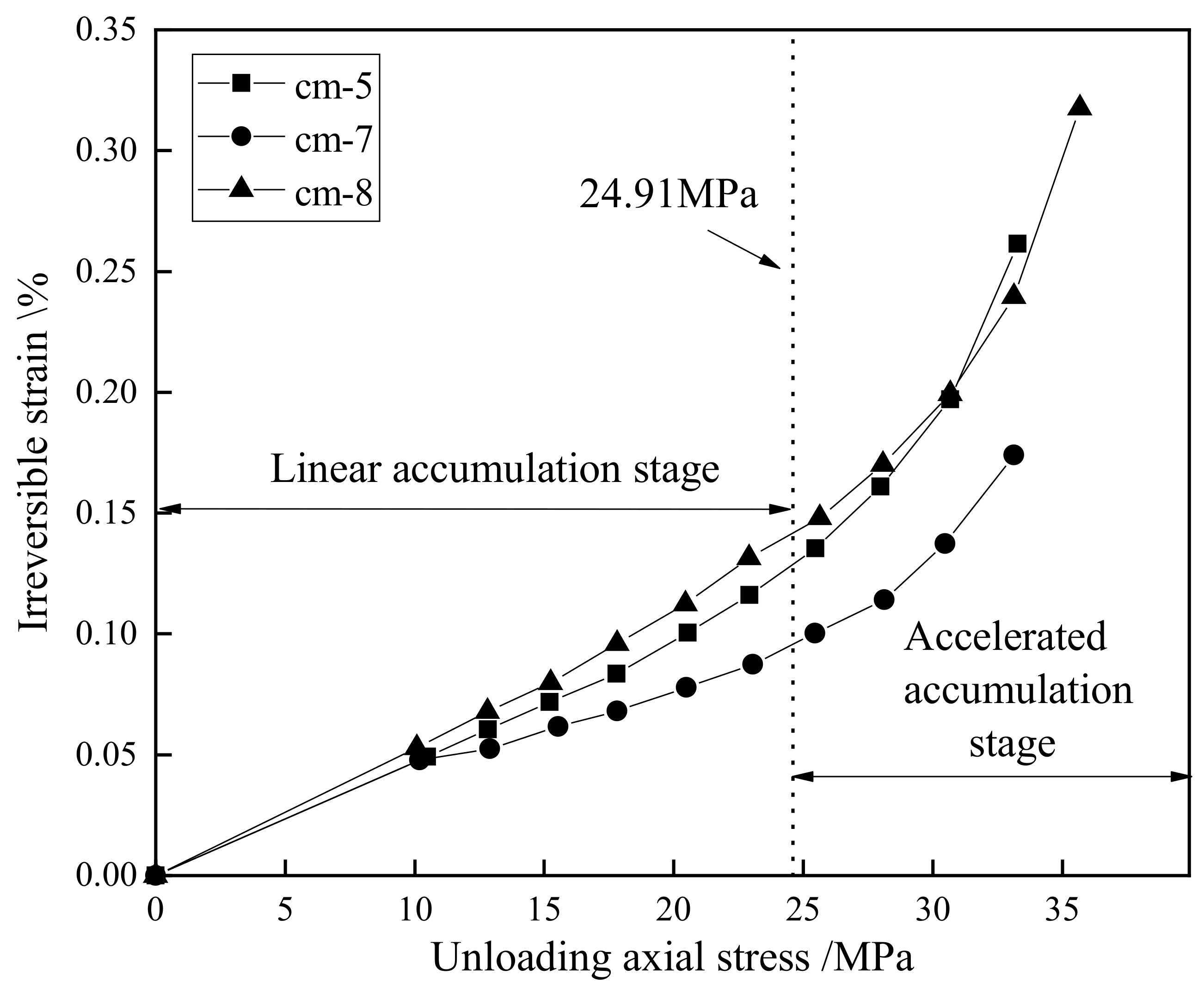
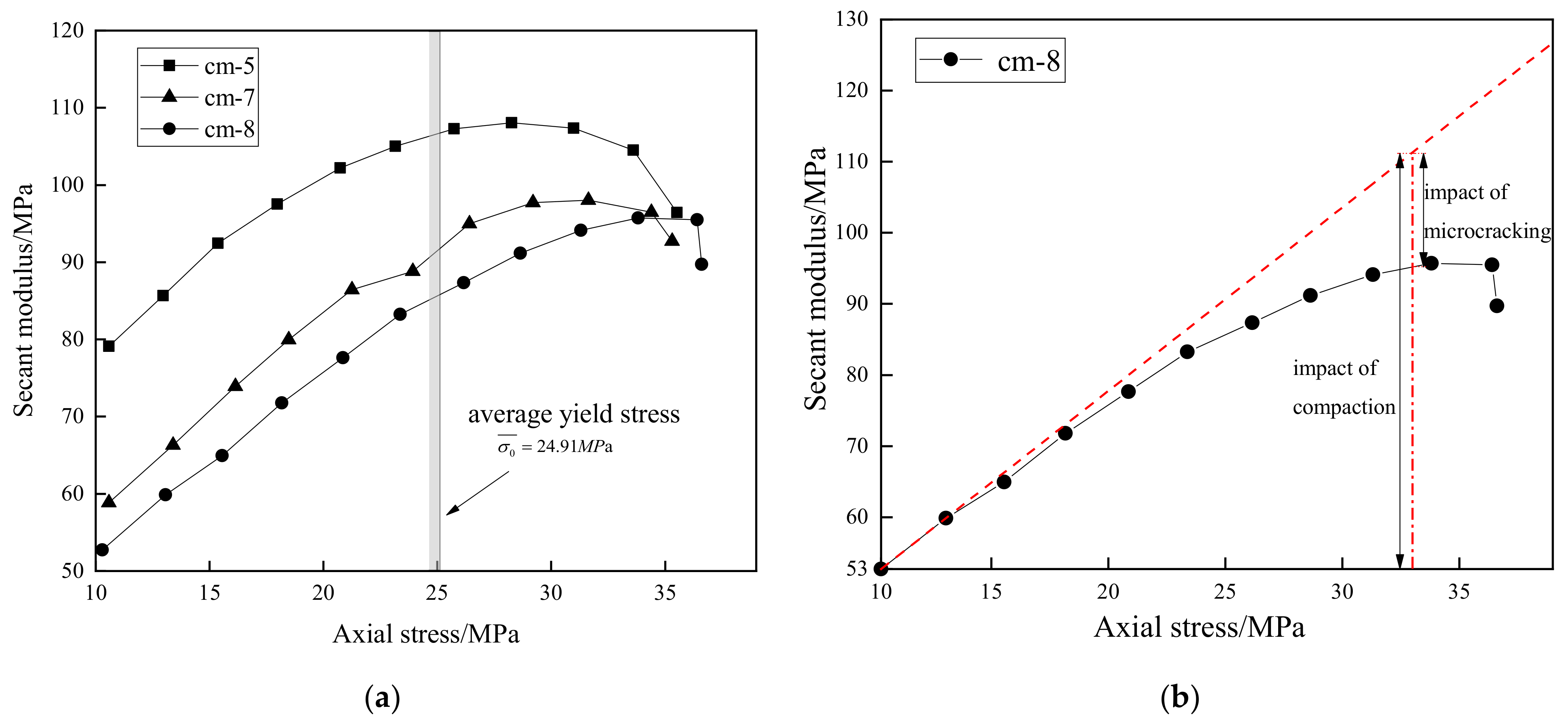
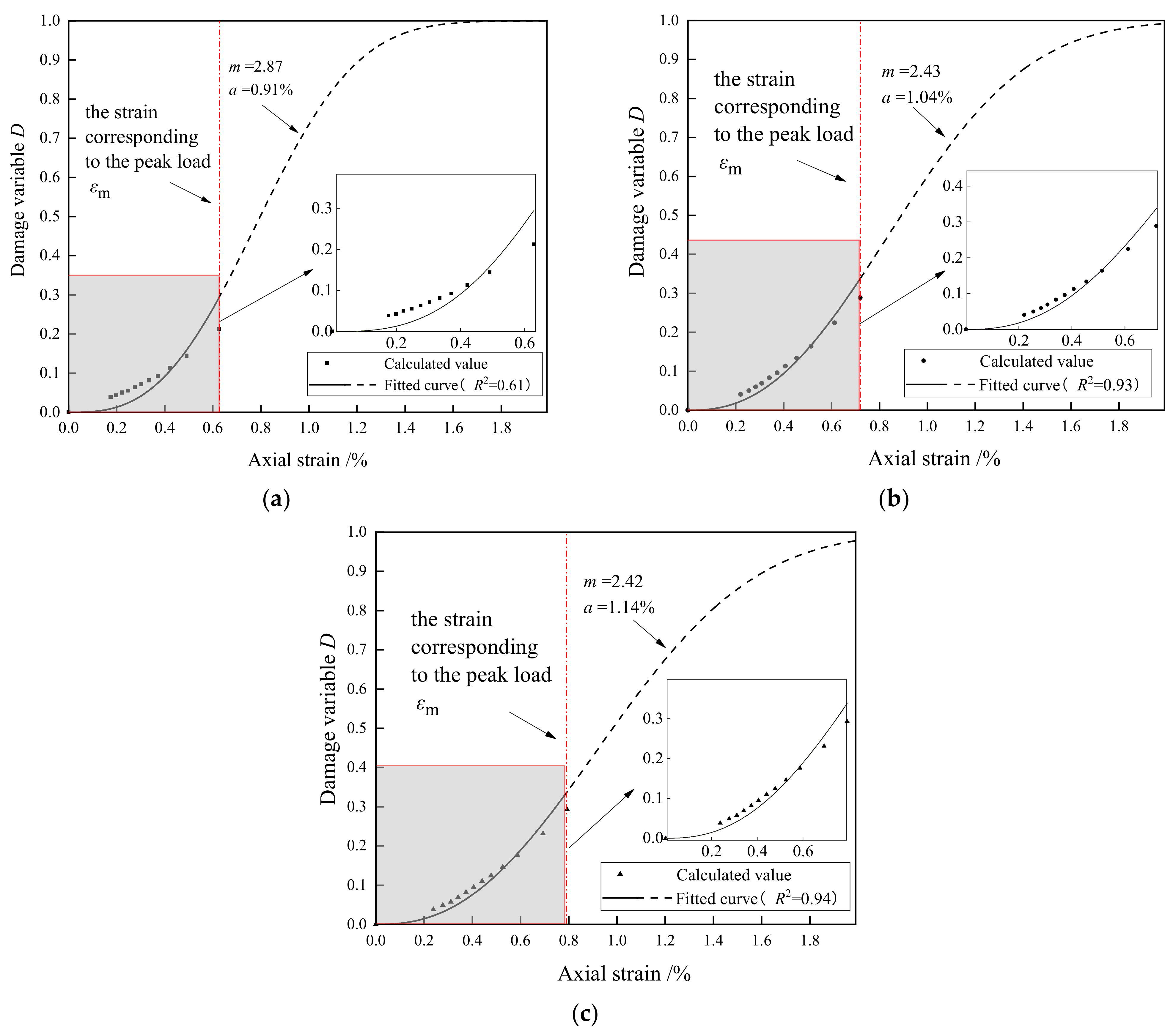
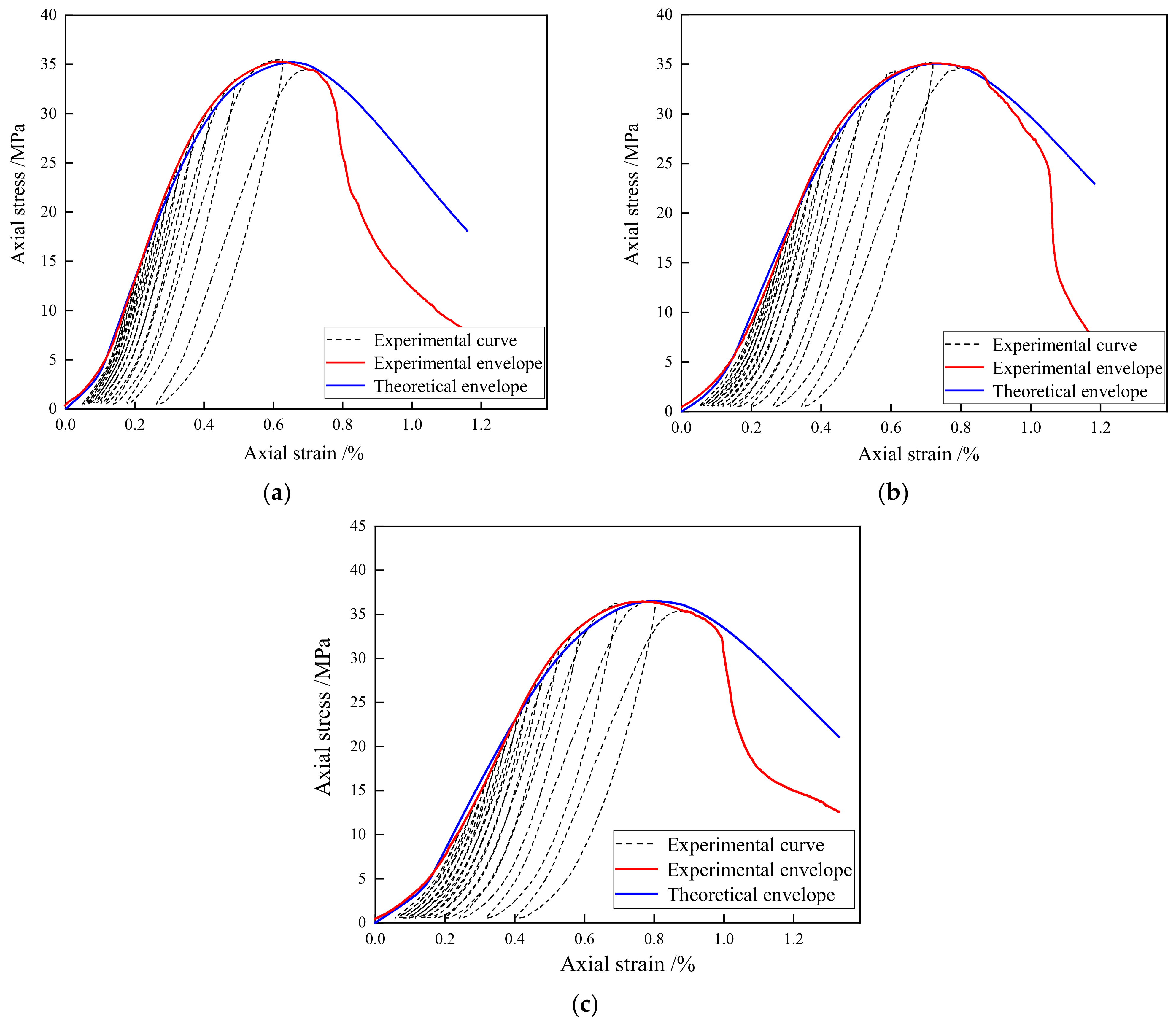
| Name | Mass (g) | Density (g/cm3) | Longitudinal Wave Velocity (m/s) |
|---|---|---|---|
| cm-1 | 394.1 | 2.08 | 3594 |
| cm-2 | 400.8 | 2.07 | 3508 |
| cm-4 | 405.1 | 2.11 | 3485 |
| cm-5 | 397.3 | 2.04 | 3540 |
| cm-7 | 395.7 | 2.10 | 3526 |
| cm-8 | 402.0 | 2.11 | 3578 |
| Type of Tests | Name | Peak Stress (MPa) | Young’s Modulus (GPa) |
|---|---|---|---|
| Uniaxial compression tests | cm-1 | 36.13 | 10.23 |
| cm-2 | 35.86 | 10.50 | |
| cm-4 | 37.08 | 9.89 | |
| Mean value | 36.35 | 10.21 | |
| Uniaxial cyclic loading and unloading tests | cm-5 | 35.52 | 9.89 |
| cm-7 | 35.31 | 8.64 | |
| cm-8 | 36.61 | 7.80 | |
| Mean value | 35.81 | 8.78 |
| Cycle Number | Irreversible Strain (%) | ||
|---|---|---|---|
| cm-5 | cm-7 | cm-8 | |
| 1 | 0.0478 | 0.0491 | 0.0529 |
| 2 | 0.0526 | 0.0604 | 0.0679 |
| 3 | 0.0616 | 0.0719 | 0.0797 |
| 4 | 0.0682 | 0.0836 | 0.0960 |
| 5 | 0.0779 | 0.1004 | 0.1135 |
| 6 | 0.0875 | 0.1161 | 0.1315 |
| 7 | 0.1003 | 0.1366 | 0.1532 |
| 8 | 0.1141 | 0.1610 | 0.1726 |
| 9 | 0.1395 | 0.1982 | 0.2032 |
| 10 | 0.1774 | 0.2711 | 0.2446 |
| 11 | 0.2618 | 0.3494 | 0.3210 |
| 12 | - | - | 0.4068 |
| Deformation Stage | Axial Strain (%) | Absolute Errors of Stress (MPa) | ||||
|---|---|---|---|---|---|---|
| cm-5 | cm-7 | cm-8 | Maximum Errors | Average Errors | ||
| Pre-peak | 0.2 | 0.17 | 0.99 | 0.99 | 0.99 | 0.54 |
| 0.4 | 0.81 | 0.77 | 0.02 | |||
| 0.6 | 0.01 | 0.17 | 0.95 | |||
| Post-peak | 0.8 | 7.21 | 0.12 | 0.13 | 15.62 | 6.84 |
| 1.0 | 12.21 | 1.74 | 3.36 | |||
| 1.2 | 10.26 | 15.62 | 10.95 | |||
Publisher’s Note: MDPI stays neutral with regard to jurisdictional claims in published maps and institutional affiliations. |
© 2022 by the authors. Licensee MDPI, Basel, Switzerland. This article is an open access article distributed under the terms and conditions of the Creative Commons Attribution (CC BY) license (https://creativecommons.org/licenses/by/4.0/).
Share and Cite
Liu, D.-H.; Qin, Y.; Zhuo, L.; Liu, J.-F.; Zheng, Z.-Q.; Pei, J.-L.; Liu, H.-Z. Compaction Behavior and Damage Constitutive Model for Porous Cement Mortar under Uniaxial Cyclic Loads. Materials 2022, 15, 8302. https://doi.org/10.3390/ma15238302
Liu D-H, Qin Y, Zhuo L, Liu J-F, Zheng Z-Q, Pei J-L, Liu H-Z. Compaction Behavior and Damage Constitutive Model for Porous Cement Mortar under Uniaxial Cyclic Loads. Materials. 2022; 15(23):8302. https://doi.org/10.3390/ma15238302
Chicago/Turabian StyleLiu, De-Hang, Yue Qin, Li Zhuo, Jian-Feng Liu, Zhao-Qiang Zheng, Jian-Liang Pei, and Huai-Zhong Liu. 2022. "Compaction Behavior and Damage Constitutive Model for Porous Cement Mortar under Uniaxial Cyclic Loads" Materials 15, no. 23: 8302. https://doi.org/10.3390/ma15238302
APA StyleLiu, D.-H., Qin, Y., Zhuo, L., Liu, J.-F., Zheng, Z.-Q., Pei, J.-L., & Liu, H.-Z. (2022). Compaction Behavior and Damage Constitutive Model for Porous Cement Mortar under Uniaxial Cyclic Loads. Materials, 15(23), 8302. https://doi.org/10.3390/ma15238302







